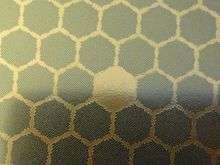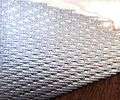Niobium-titanium
Niobium-titanium (NbTi) is an alloy of niobium and titanium, used industrially as a type II superconductor wire for superconducting magnets, normally as Nb-Ti fibres in an aluminium or copper matrix.
Its critical temperature is 9.2 kelvin[1]
In 1962, at Atomics International, T.G. Berlincourt and R.R.Hake.[2] discovered the superior high-critical-magnetic-field, high-critical-supercurrent-density properties of Nb-Ti that, together with affordability and easy workability, distinguish Nb-Ti alloys from thousands of other superconductors and justify their status as the most widely utilized (workhorse) superconductors.
With a maximum critical magnetic field of about 15 tesla, Nb-Ti alloys are suitable for fabricating supermagnets generating magnetic fields up to about 10 tesla. For higher magnetic fields, higher-performance, but more-expensive and less-easily fabricated superconductors, such as niobium-tin, are commonly employed.
The part of global economic activity, for which superconductivity is indispensable, amounted to about five billion euros in 2014. [3] MRI systems, most of which employ niobium-titanium, accounted for about 80% of that total.
Notable uses
Superconducting magnets
A bubble chamber at Argonne National Laboratory has a 4.8-meter-diameter Nb-Ti magnet producing a magnetic field of 1.8 tesla.[4]
About 1000 NbTi SC magnets were used in the 4-mile-long main ring of the Tevatron accelerator at Fermilab.[5] The magnets were wound with 50 tons of copper cables containing 17 tons of NbTi filaments.[6] They operate at 4.5 K generating fields up to 4.5 tesla.
1999: The Relativistic Heavy Ion Collider uses 1,740 NbTi SC 3.45 tesla magnets to bend beams in its 3.8 km double storage ring.[7]
In the Large Hadron Collider particle accelerator the magnets (containing 1200 tonnes of NbTi cable[8]) are cooled to 1.9 K to allow safe operation at fields of up to 8.3 T.
Niobium-titanium superconducting magnet coils (liquid helium cooled) were built to be used in the Alpha Magnetic Spectrometer mission to be flown on the international space station. They were later replaced by non-superconducting magnets.
The experimental fusion reactor ITER uses Niobium-titanium for its poloidal field coils. In 2008 a test coil achieved stable operation at 52 kA and 6.4 Tesla.[9]

See also
References
- ↑ Flükiger, R.; Hariharan, S. Y.; Küntzler, R.; Luo, H. L.; Weiss, F.; Wolf, T.; Xu, J.Q. (1994). Flükiger, R.; Klose, W., eds. Nb-Ti. 21b2: Nb-H - Nb-Zr, Nd - Np (The Landolt-Börnstein Database ed.). SpringerMaterials. doi:10.1007/10423690_53. ISBN 3-540-57541-3..
- ↑ T.G. Berlincourt and R.R. Hake, “Pulsed-Magnetic-Field Studies of Superconducting Transition Metal Alloys at High and Low Current Densities,” Bull. Am. Phys. Soc. II 7 408 (1962) and T.G. Berlincourt, “Emergence of Nb-Ti as Supermagnet Material,” Cryogenics 27, 283 (1987)
- ↑ http://www.conectus.org/xxmarket.html
- ↑ http://hyperphysics.phy-astr.gsu.edu/Hbase/solids/scmag.html
- ↑ http://supercon.lbl.gov/SuperconDocuments/SSC-MAG-81-1986.pdf
- ↑ http://lss.fnal.gov/archive/test-tm/0000/fermilab-tm-0763.pdf The Tevatron 1978
- ↑ http://www.bnl.gov/magnets/RHIC/RHIC.asp
- ↑ http://www.iop.org/EJ/abstract/0953-2048/23/3/034001/
- ↑ "Milestones in the History of the ITER Project". iter.org. 2011. Retrieved 31 March 2011.
The test coil achieves stable operation at 52 kA and 6.4 Tesla


